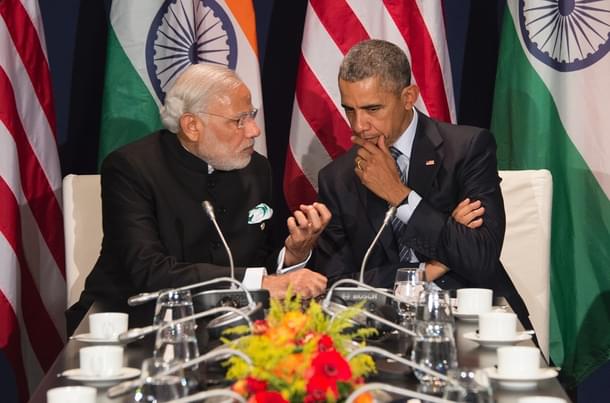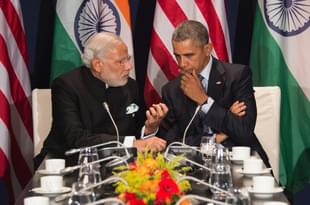World
Modi Goes To US And This Visit Is Different From The Rest
Ashok Sajjanhar
Jun 04, 2016, 02:14 AM | Updated 02:14 AM IST
Save & read from anywhere!
Bookmark stories for easy access on any device or the Swarajya app.


Prime Minister Narendra Modi is embarking on a two-day visit (7-8 June) to the US and this will be his fourth travel to America in two years after assuming power. But this visit will be quite different from the tours he has undertaken to the US. All the earlier visits were in connection with multi-lateral or inter-governmental meetings ie in Sept, 2014 and Sept, 2015 he travelled in connection with UN General Assembly Session and UN Sustainability Development Summit respectively. Tour on 31st March-2nd April this year was in connection with the Nuclear Security Summit convened by President Obama. The forthcoming sojourn will be the first that Modi will undertake in the bilateral context.
This visit will be the last opportunity for substantive interaction between the two leaders. Past experience has demonstrated that US Presidents tend to become more assertive and bold in the last year of their tenure as they become increasingly focussed on their legacy and how history will judge them. Obama has already accumulated a huge pile of achievements in addition to the Nobel Peace Prize (that was thrust upon him in the first year of his Presidency) including transformation in bilateral relations with Iran, Cuba, Myanmar, visits to Vietnam, Hiroshima etc which have clearly reserved his place in history of contemporary times. Strong upward trajectory in India-US bilateral relations, particularly over the last two years, can be a matter of intense shared satisfaction for both leaders.
While Modi’s visit will provide an opportunity to both sides to reflect on what has been accomplished, it will also contribute to reinforcing relations between the two strategic partners. As put out in the Press Release by the Ministry of External Affairs : ‘’ The main objective of forthcoming visit of Prime Minister would be to consolidate the progress made in diverse areas such as economy, energy, environment, defence and security, and to intensify cooperation for the future’’.
Deepening and diversification of ties with USA is one of the more significant success stories of Modi’s foreign policy. This is reflected not only in the number of visits by Modi to the US, the most by him to any country, but also in the historic visit by Barack Obama to India in Jan, 2015, becoming the first US president to visit India twice during his tenure and also the first time that a US President attended India’s Republic Day celebrations as Chief Guest. The existing cooperation has expanded in several substantive areas including energy, renewable energy, high technology, defence, education, agriculture, trade, investment etc..There is a growing convergence of strategic interests.
A significant highlight of the visit will be Modi’s Address to the Joint Session of US Congress. This will provide him an opportunity to chart out his vision of future India-US ties and how the two large democracies can collaborate to ensure peace, security, stability and prosperity in the world. The US Congress has always been supportive of closer India-US ties and PM Modi can be assured of a warm, enthusiastic reception by members. Modi will be only the 5th Indian Prime Minister to speak to the Joint Session, the earlier ones having been Dr Manmohan Singh (2005), Atal Behari Vajpayee (2000), Narasimha Rao (1994) and Rajiv Gandhi (1985). The Address will be followed by a rare lunch by Speaker Paul Ryan which will be attended by Vice President Joe Biden and several Cabinet Ministers. This demonstrates the wide and bipartisan support that India and Prime Minister Modi enjoy in the two Houses of Congress.
Defence has emerged as an area of high importance in bilateral ties with USA having become the largest defence supplier to India by overtaking Russia in a short span of 10 years since the bilateral Defence Agreement was signed during the then Defence Minister Pranab Mukherjee’s visit to Washington DC in April, 2005. From a modest figure of $300 million eight years ago, US has risen to be the top supplier with total orders of $14 billion today. It is likely that the three ‘’foundational’’ defence Agreements viz Logistics Support Agreement (LSA), Communication Interoperability and Security Memorandum of Agreement (CISMOA), and Basic Exchange Cooperation Agreement (BECA) are inked during Modi’s visit. This will open the way for even closer cooperation in this area. Several initiatives for co-production and co-development of many next generation technologies have already been launched.
Another significant development is the recent move by a bipartisan group in the US Senate exhorting the US Secretary of Defense to establish closer military and intelligence cooperation between India and the US. The Defense Secretary has been asked to ensure that India-US co-operation is at the same level as with NATO allies and appropriate to developing threat analysis, military doctrine, force planning, logistic support, intelligence collection and analysis, tactics, techniques and procedures, and humanitarian assistance and disaster relief.
The visit could witness agreement on setting up six nuclear power plants in India. Way for this was cleared during Obama’s visit to India last year when the issue of liability for any possible nuclear accident was resolved. This is an ambitious number although it is still far short of the twelve that have been agreed upon with Russia.
Discussions are likely to take place on the long pending Bilateral Investment Agreement (BIT). Some progress may take place although it is unlikely that a final text will emerge during the visit.
What will perhaps be the most critical element of the visit will be the one-to-one discussions between the two leaders on the strategic dimensions of the partnership. Of particular relevance will be bilateral parleys on increasing assertiveness of China in the South China Sea, its forays in the Indian Ocean, its expanding engagement with Russia, and the growing apprehension and nervousness of its neighbours. In this context it is noteworthy that USA had recently come out clearly in support of India’s claim to NSG membership, rejecting doubts and questions raised by China on the issue. Peace and stability in Afghanistan and continuing turmoil in Middle East including rising tensions between Iran and Saudi Arabia are likely to be fully discussed.
Bilateral ties between India and the US have been transformed from being purely transactional to a strategic partnership. While India’s ties with USA provide it with strategic space and maneuverability to deal with China’s increasingly overbearing attitude, India needs to make certain that it is not seen succumbing to the US embrace and should maintain vibrant and prolific ties with its other significant partners like Russia, Japan and China.
The first bilateral visit by Modi to the US will be an opportunity for the two leaders to applaud the long distance travelled in bilateral relations over the last two years. In addition, the parleys can be expected to give a significant impetus to the partnership in strategic, political, defence, economic and cultural spheres.
The author is a former Ambassador of India to Kazakhstan, Sweden and Latvia. He is currently President, Institute of Global Studies.”




